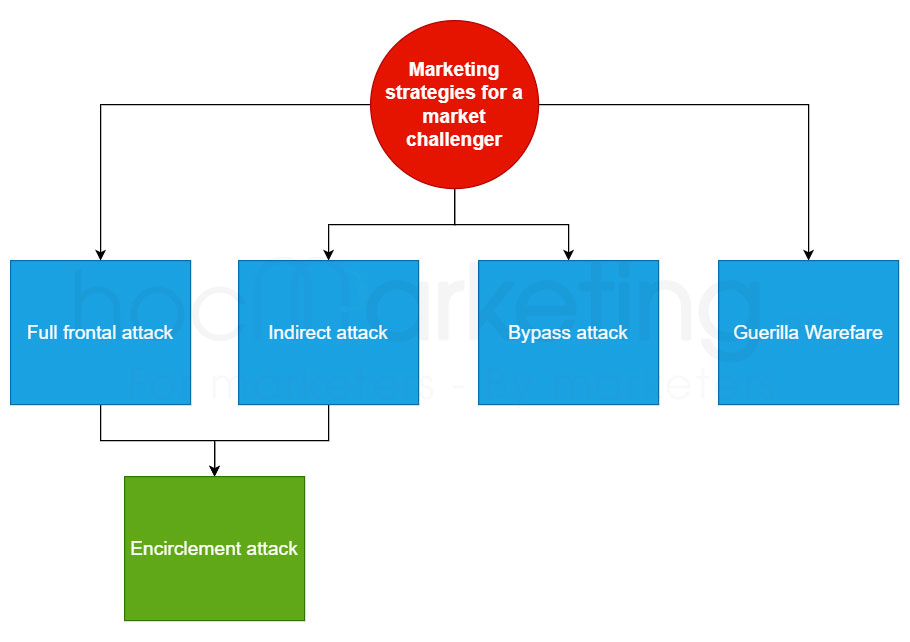
What is a market challenger? Strategies to challenge a market

Competition is the nature in modern markets. Once a company enter a new market, there will be many ones who follow. Once a company become the market leader, there would be others as the market challengers. This blog post will explain what a market challenger is and provide marketing strategies for market challengers.
Business is a process that requires businesses to constantly change to compete with competitors and develop sustainably. In a market, businesses with different sizes and levels of development will be divided into different groups: market leader, market challenger and market follower. Within the framework of this article, hocmarketing.org will give you an overview of the concept of “Market challenger” and some marketing strategies that bring outstanding results for businesses that are aspiring to hold a position. This blog post will explain what a market challenger is and provide marketing strategies for market challengers.
What is a market challenger?
A market challenger is a company which tries to break the existing market leader position and take its place by offering better products, services or even prices than those of their competitors. According to many marketing documents, market challengers are considered as ones taking the 2nd or 3rd position in the market.
Often times, market challengers are considered as firms trying to achieve the leadership position in their markets. They are considered as "economic soldiers" who try to win against strong competitors with their competitive weapons like lower prices, good quality products or good services (Kotler & Keller, 2009).
For example:
In the US, the No. 1 automobile market is occupied by General Motors (GM). The No. 2 company is Ford and the No. 3 one is Chrysler LLC. Both Ford and Chrysler try to become the no.1 company by trying to provide better products, services or prices than those of GM's ones.
In Europe, the No. 1 automobile market is occupied by Volkswagen (VW) while the No. 2 company is Opel and the no. 3 one is Ford Europe. All three companies try to become the no.1 company by trying to provide better products, services or prices than those of VW's ones
What factors make a company become a market challenger?
Market challengers have many competitive advantages. There are some roadblocks prevent them from taking the first place as the market leader. Here are some factors which make a company become a market challenger:
1. Entering the market later but adapt the situation faster
Market challengers often enter the market later (than the market leader). However, they can create or adopt their strategies faster than the market leader. They catch up with the market leader position quickly and try to take their place in a short time compared to other firms.
2. Offering products/services which are high-quality as ones from the market leader
Most market challengers try to offer products/services which are as good as those of the market leader company. In this way, consumers will believe that they can make a right decision by choosing between the existing market leader and new market challenger based on their demands and needs.
3. Having a good brand which can overtake the position of the market leader
A market challenger always have a good brand. Because they know that they are not the Number 1, therefore, thay are always focus on improving their brand which can can overtake the position of the market leader in one day.
4. Building a good relationship with customers
Market challengers try to develop a good relationship with their target customers by trying to understand their key needs and offering them the best products/services. In this way, market challengers can get trust from consumers and build loyalty among them for a long term.
Competitive Marketing strategies for a market challenger
As the runner-up in a market, a market challenger usually has an aggressive marketing strategy. They often tend to highly attack the market leader to claim its position. Below are the commons competitive strategies that a market challenger often use:
1. Full frontal attack.
Full frontal attack is a marketing strategy which match the competitor’s product, advertising, price, and distribution efforts. It attacks the competitor’s strengths rather than its weaknesses. The outcome depends on who has the greater strength and endurance. Sometimes, full frontal attack can become a price war which will destroy the market.
For example, PepsiCo uses this strategy against Coca-Cola by offering more flavors, lower prices and increased advertising.
Full frontal attack should be used by firms which have large resources. The ultimate target of the strategy is to gain the market share from the market leader. Profit losses are likely to happen when using this strategy.
2. Indirect attack.
If the market challenger has fewer resources than the competitor, however, a frontal attack makes little sense. Thus, many new market entrants avoid frontal attacks, knowing that market leaders can head them off with ad blitzes, price wars, and other retaliations. Rather than challenging head-on, the challenger can make an indirect attack on the competitor’s weaknesses or on gaps in the competitor’s market coverage. It can carve out toeholds using tactics that established leaders have trouble responding to or choose to ignore. This gives the new entrant an opportunity to gain a foothold before the market leader has time to respond.
For example, in 1985 IBM attacked Apple with a TV ad that called Apple “the most expensive computer around” and showed people climbing over each other for IBM products. In response, Apple ran full page ads in major newspapers declaring: “Welcome IBM. Seriously.”
3. Encirclement attack.
Encirclement attack is the combination of full frontal attack and indirect attack, which both challenges the leader's strengths and exploits the market leader’s weaknesses.
For example, when HP acquired Compaq in 2002, it used the en-cirlement attack against Dell. It spent more than US$1 billion on market development activities to build its brand image and customer base before attacking Dell head-on by slashing the price of printers and notebook PCs in order to gain share against Dell’s direct sales channel.
4. Bypass attack.
Bypass attack is used by market challengers which cannot directly challenge the market leader and need to find another way to enter a market.
If, after considerable effort, a firm finds that it cannot compete with the existing leader, it might consider bypassing the leader’s position altogether by finding or creating an opening in another part of the industry.
For example, in the 1970s automakers began to ask rental car companies for permission to sell their vehicles. Without building factories of their own, GMAC and then other automakers successfully offered new lines of cars with no-haggle prices at low margins to consumers who would not otherwise have bought a vehicle.
5. Guerrilla Warfare.
Guerrilla warfare is a strategy whereby a market challenger keeps costs low and plans for lean, rapid growth. It often begins with a very small investment and uses temporary locations, skimming pricing, a high-profile marketing campaign, and flexible compensation schemes to attract customers from the leader.
For example, against GM’s Saturn line of small, fuel-efficient cars, Japanese automakers used a guerrilla marketing campaign in California that started with one car dealership and then increased the number of dealerships gradually.
Summary
If you are a market challenger, it is important that you have an aggressive marketing strategy. You should know your strengths and weaknesses to effectively fight against the market leader in your industry. One of the most popular strategies for challengers is full frontal attack which aims to take over their position by gaining more customers than them with lower priced items or better customer service. However, if this doesn’t seem feasible then indirect attacks may be effective as well because they focus on taking advantage of any gaps in coverage from the competitor rather than attacking head-on. Consider these tips when formulating your own competitive marketing strategy!
















